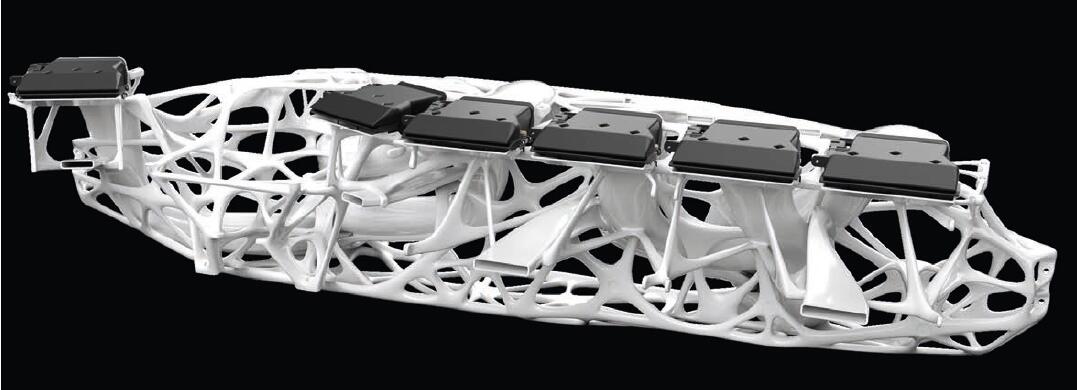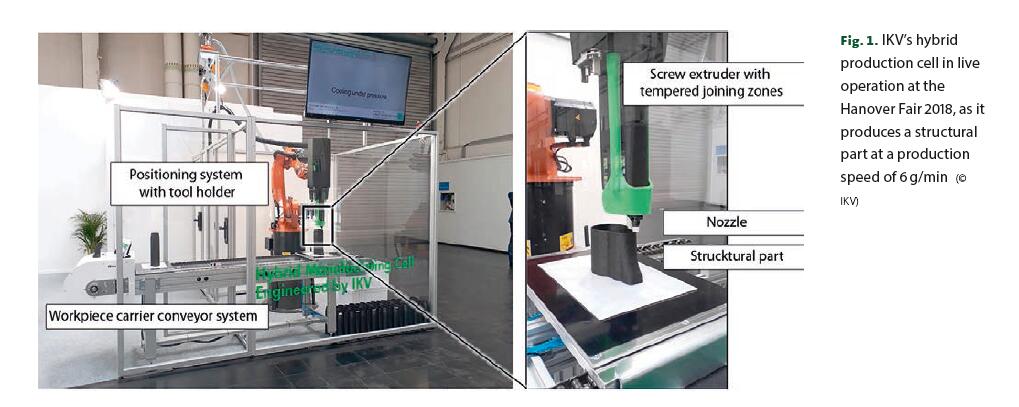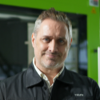SPECIAL: ADDITIVE MANUFACTURING Layer-by-Layer from Granulate to Part——High-Speed Additive Manufacturing of Fiber-Reinforced Structural Parts
Abstract:
SPECIAL: ADDITIVE MANUFACTURING Layer-by-Layer from Granulate to Part——High-Speed Additive Manufacturing of Fiber-Reinforced Structural Parts
In the November 2018 issue of Kunststoffe International, the SPACE A of the Yizumi robot flexible additive manufacturing system was introduced. This system can be combined with existing (such as injection molded or die cast components) production chains to process functional structures in a subsequent manner by additive manufacturing. In this way, the injection molding process is combined with additive manufacturing to economically produce multi-component parts.
Yizumi is preparing to introduce a hybrid manufacturing unit which features a new screw-based plasticizing unit mounted on a six-axis robot. This new method of processing enables the additive manufacturing of structural parts from granular and standard fiber-reinforced compounds.
A new joint venture is getting a hybrid manufacturing cell ready for market. A screw- based plasticizing unit is mounted on a 6-axis robot. The novel processing approach facilitates additive manufacturing of structural parts from granular and fiber-reinforced standard compounds.

Concept study of an integrative, bionic carrier structure for instrument panels in cars (© SMP Deutschland GmbH)
Additive manufacturing processes are ideal for three-dimensional parts that can be produced directly on the basis of CAD data and without the use of tools. Consequently, plastics-based additive manufacturing has become well established for making prototypes. In the future, additive manufacturing methods will probably replace previous, cost-intensive single and/or small batch production by rapid manufacturing.
However, the process requirements – indispensably demanded for pre-series production – are still not entirely met. The production of large-scale parts with good surface qualities cannot be realized in short production times. Neither a high productivity in terms of materials, machines, and performance, nor the use of established, series-qualified materials is possible. The concept presented here for screw-extrusion-based additive manufacturing (SEAM) within a hybrid production approach (Hy-SEAM) offers a new way to economically generate geometrically complex, large-scale parts from thermoplastic polymers.
2. SPECIAL ADDITIVE MANUFACTURING
Highly Filled Compounds

Fig. 1. IKV’s hybrid production cell in live operation at the Hanover Fair 2018, as it produces a structural part at a production speed of 6 g/min (© IKV)
Award-Winning Interior ConceptStudy
Within a concept study by automotive supplier SMP Deutschland GmbH, Bötzingen, Germany, an application example of large-format additive manufacturing is illustrated. The 167 cm wide instrument panel carrier (Title figure) features a bionic structure that has won the SPE Innovation Award 2018 for structural parts. It combines the crossbeam, air ducts and mounting points for airbags, steering column, displays, and covers. Due to its topology-optimized lightweight design, it uses the material efficiently, thereby reducing material consumption. Moreover, functional integration increases machine productivity by eliminating downstream processing steps, such as the joining or mounting of components. In an overall concept with greatly reduced tooling invest, rapid manufacturing will enable economical production of such structures for small series.
However, the series production of such a carrier structure cannot be realized using the additive manufacturing methods established in the market today. On the one hand, the available production methods are limited in respect to part size, surface quality, functional integration, and production time. On the other hand, the range of applicable materials for additive manufacturing is severely limited. When filament-based processes are used, processors are dependent on filament manufacturers and their high filament prices. Furthermore, highly reinforced plastics have hardly been utilized, which in turn has impeded the production of parts with targeted anisotropic mechanical properties.
At the Institute of Plastics Processing (IKV) at RWTH Aachen University, Germany, an additive production system is being introduced that exceeds the capabilities of familiar filament-based systems. It includes the capabilities of the constantly growing automation sector and pursues a future-oriented approach that efficiently exploits the technological potential.
Hybrid Production Concept, New Areas of Application
The base of the development is a hybrid production cell based on screw-based extrusion. The system enables the automated combination of subtractive and additive production methods. The IKV introduced it at the IKV colloquium 2016, presented it to the public at the K 2016, and since then has continuously developed it (Fig. 1).
A 6-axis industrial robot is used as a linear positioning system and overcomes the usual limitations regarding part size and complicated design. To ensure reproducible dimensional stability and high surface quality without simultaneously limiting part complexity, subtractive processes (e. g., milling, drilling) are integrated into the part creation process. Thereby, additive manufacturing and machining are combined in a single production system. This approach makes it possible to integrate inserted parts, such as threaded or bearing bushes, molded parts, electronic or ceramic inserts, and to equip the part with additional functions during construction. To do so, the drive used for extrusion and machining operation is equipped with a standardized tool changing system, thus enabling high automation and flexibility.
The centerpiece of the hybrid system, the screw-based plasticizing unit operates with plastic granules. Compared with filament-based production methods, this enables processing with both unreinforced and highly reinforced plastic compounds at simultaneously high and scalable throughputs. Besides increased throughputs, a great advantage is the significantly lower price for granules (approx. EUR 1 to 8 per kg) compared to filaments (approx. EUR 20 to 500 per kg), depending on the particular material. As with all production processes, the results are dependent upon the processability of the applied material. Essentially, this applies to the aspects of dimensional stability (shrink-related) and mechanical properties (adhesion-related). The materials developers are now required to investigate which materials previously qualified for other series production processes are suitable for additive production, as well.
Suitability of Qualified Series Materials
The processing of highly reinforced plastic compounds in additive manufacturing offers new potential in terms of material selection and resulting part properties. The production of highly reinforced plastic compounds within narrow tolerance ranges is the core competency of Akro-Plastic GmbH of Niederzissen, Germany.
Using the IKV’s system technology, Akromid B3 ICF 30, a polyamide 6 with 30 wt.% short carbon fibers, about 300 μm long, was processed successfully. It is already being used in series injection molding applications. Fiber-reinforced compounds fundamentally tend to shrink less, thereby simplifying their processing by plasticizing additive production methods. Due to optimized plasticizing and flow characteristics of this polyamide compound, a robust process can be realized with high production speeds. In the case at hand, production is 28 times faster than filament-based Fused Layer Modeling (FLM). Akromid is also available in granule sizes of 1 mm x 1 mm to improve meter ability, feed behavior, and dwell times.
Extensive material testing at the IKV has shown that the properties of parts based on semi-crystalline polymers are strongly dependent upon processing temperatures. An essential advantage of plasticizing additive manufacturing processes is the strong orientation of polymer molecules and fibers. Orientation creates highly anisotropic mechanical properties in the deposited strand (Fig. 2).

Fig. 2. Mechanical properties of additively manufactured parts made from Akromid B3 ICF 30 PA6 compound depending on substrate temperature (source: IKV)
In fiber orientation, tensile strength comparable to injection molding can be achieved (Fig. 2, red reference line). Moreover, the discharge pressures in extrusion-based additive manufacturing are higher than in FLM (usually up to several 100 bar). This enables thermoplastics with higher filler contents to be processed and improves the mechanical properties of the deposited material. With a thorough 3D-printing approach, as is possible with the 6-axis kinematic used here, this anisotropy can be utilized for load path-optimized material application.
Based on these investigations, Akromid B3 ICF 30 9 AM black (7451) is now available as an optimized modification of the conventional injection molding compound.
New Joint Venture Paves the Way to Industrialization
The screw-based additive production system is being industrialized in cooperation with the equipment manufacturer Yizumi Germany GmbH, Aachen, Germany. Aiming at an industry-ready solution, the IKV and Yizumi Group will found a joint venture named “SpaceA”, whose pilot machine was successfully presented in live operation at the Fakuma 2018 and can also be seen at the Formnext 2018 (Fig. 3). The system pursues a platform strategy that enables both hybrid additive- subtractive versions, as well as simpler, screw-based extrusion solutions, depending on the application requirements. Flexible machine construction results in variable investment costs.

Fig. 3. Pilot plant with exchangeable construction bed module for application-oriented use as presented at the Fakuma (© Hanser/F. Gründel)
The system concept integrates methods of additive manufacturing for functionalization in existing production chains of, for example, injection molded or die cast components. In this way, multi-material applications can be created economically by combining an injection molding process with additive manufacturing. Thus, housing parts, for example, can be produced with local sealing or reinforcement elements. Today, this would require a multi-component process with two injection molding machines including two molds. In the future, the combination of an injection molding process with an additive manufacturing line will enable local reinforcements. The high productivity of the system technology presented here makes it possible to apply sealings or reinforcement structures to the part within the cycle time of the injection molding process. This will save a second injection molding machine, while lowering mold investment significantly. Production flexibility will be increased simultaneously, thereby making it possible to economically produce several product versions.
Conclusions
The new process will be developed and marketed via the joint venture with Yizumi and in technological cooperation with companies along the entire value chain. Continuous development of this production technology will expand the limits of additive manufacturing and its transfer to series production. The further development of existing series compounds and new materials will contribute to this expansion, as well. The results relating to the strong anisotropy in mechanical properties will be a special challenge for the software branch. Economical and fast CAM systems are required for load path-oriented part construction. The machine hardware and raw materials are available and can be utilized selectively.
The Authors
Prof. Dr-Ing. Christian Hopmann is the Director of the Institute of Plastics Processing (IKV) in Aachen, Germany.
Celina Hellmich is employed as a scientific associate for additive manufacturing at the IKV.
Nicolai Lammert is the Acting Director of additive manufacturing at Yizumi Germany GmbH; n.lammert@yizumi-germany.de
Dr. Jan Dormanns is employed as an advanced development engineer for interiors at SMP Deutschland GmbH of Bötzingen, Germany.
Jürgen Rinderlin is employed as an advanced development engineer for exteriors at SMP.
Thilo Stier heads the department of sales & innovation at Akro-Plastic GmbH of Niederzissen, Germany.
Josef Zgrzebski is employed as an application engineer at Akro-Plastic GmbH.
THE NEW BRAND FOR EUROPE.
Layer-by-Layer from Granulate to Part
High-Speed Additive Manufacturing of Fiber-Reinforced Structural Parts
https://www.kunststoffe.de/en/journal/archive/article/high-speed-additive-manufacturing-of-fiber-reinforced-structural-parts-7079955.html





